Development of a Wearable Reflection-Type Pulse Oximeter System to Acquire Clean PPG Signals and Measure Pulse Rate and SpO2 with and without Finger Motion
Abstract
1. Introduction
2. Related Works
3. Our Contribution
- We propose an electronic circuit using an analog filter that contributes to acquire clean PPG signals.
- To measure SpO2, our proposed system interfaces with an optocoupler, which serves to separate the red and green LED signals.
- Generally, it is known that a single cycle of the PPG signal can be used to measure PR. However, our experiments showed that the pulse period for each PPG cycle was not the same. Hence, we propose an algorithm that can detect similar periods of PPG cycles, which we call “true” PPG signals. In this manuscript, our proposed PR measurement algorithm also helps in distinguishing the true PPG signals from the sequential PPG signals.
- We also consider three kinds of finger motions while measuring PR. By increasing the moving average window for processing the PPG signals, we mitigate the finger motion artifact noise. This feature can be used for monitoring seriously ill patients.
- We show possible applications of our proposed wearable PO device as a wearable, hand-held device, and clean PPG signal acquisition system through USB to serial communication.
- To use our proposed wearable PO device as a hand-held PO device, we design a smartphone app that can be used to monitor PR and SpO2 through a Bluetooth connection between the smartphone and device.
4. Proposed Method
4.1. Proposed Electronic Circuit for PPG Signal Acquisition
4.2. Proposed PR and SpO2 Measurement Algorithm
4.3. Analyzing and Removing Finger Motion Artifact
5. Hardware Implementation
6. Results and Discussion
6.1. MAPE
6.2. MAE
6.3. RCF
6.4. Evaluation of the Proposed Electronic Circuit
7. Possible Application of Our Proposed Wearable PO Device
8. Conclusions
Author Contributions
Funding
Conflicts of Interest
References
- Winkley, J.; Jiang, P.; Jiang, W. Verity: An ambient assisted living platform. IEEE Trans. Consum. Electron. 2012, 58, 364–373. [Google Scholar] [CrossRef]
- Mukhopadhyay, S.C. Wearable sensors for human activity monitoring: A review. IEEE Sens. J. 2015, 15, 1321–1330. [Google Scholar] [CrossRef]
- Elgendi, M. On the analysis of fingertip photoplethysmogram signals. Curr. Cardiol. Rev. 2012, 8, 14–25. [Google Scholar] [CrossRef] [PubMed]
- Shelley, K.H. Photoplethysmography: Beyond the calculation of arterial oxygen saturation and heart rate. Anesth. Analg. 2007, 105 (Suppl. S6), S31–S36. [Google Scholar] [CrossRef] [PubMed]
- Alnaeb, M.E.; Alobaid, N.; Seifalian, A.M.; Mikhailidis, D.P.; Hamilton, G. Optical techniques in the assessment of peripheral arterial disease. Curr. Vasc. Pharmacol. 2007, 5, 53–59. [Google Scholar] [CrossRef] [PubMed]
- Allen, J. Photoplethysmography and its application in clinical physiological measurement. Physiol. Meas. 2007, 28, R1–R39. [Google Scholar] [CrossRef] [PubMed]
- Sommer, J.R.; Farley, R.T.; Graham, K.R.; Yang, Y.; Reynolds, J.R.; Xue, J.; Schanze, K.S. Efficient near-infrared polymer and organic light-emitting diodes based on electrophosphorescence from (tetraphenyltetranaphtho[2,3]porphyrin)platinum(II). ACS Appl. Mater. Interfaces 2009, 1, 274–278. [Google Scholar] [CrossRef] [PubMed]
- Hossain, S.; Kwon, T.-H.; Kim, K.-D. Comparison of different wavelengths for estimating SpO2 using beer-lambert law and photon diffusion in PPG. In Proceedings of the 10th International Conference on Information and Communication Technology Convergence (ICTC 2019), Jeju Island, Korea, 16–18 October 2019; pp. 1377–1379. [Google Scholar]
- Lochner, C.M.; Khan, Y.; Pierre, A.; Arias, A.C. All-organic optoelectronic sensor for pulse oximetry. Nat. Commun. 2014, 5, 5745. [Google Scholar] [CrossRef]
- Khan, Y.; Lochner, C.M.; Pierre, A.; Arias, A.C. System design for organic pulse oximeter. In Proceedings of the 6th International Workshop on Advances in Sensors and Interfaces (IWASI), Gallipoli, Italy, 18–19 June 2015; pp. 83–86. [Google Scholar] [CrossRef]
- Maeda, Y.; Sekine, M.; Tamura, T.; Moriya, A.; Suzuki, T.; Kameyama, K. Comparison of reflected green light and infrared photoplethysmography. In Proceedings of the IEEE Engineering in Medicine and Biology Society. Annual Conference, Vancouver, BC, Canada, 20–25 August 2008; pp. 2270–2272. [Google Scholar] [CrossRef]
- Chatterjee, S.; Abay, T.Y.; Phillips, J.P.; Kyriacou, P.A. Investigating optical path and differential pathlength factor in reflectance photoplethysmography for the assessment of perfusion. J. Biomed. Opt. 2018, 23, 075005. [Google Scholar] [CrossRef]
- Dremin, V.; Zherebtsov, E.; Bykov, A.; Popov, A.; Doronin, A.; Meglinski, I. Influence of blood pulsation on diagnostic volume in pulse oximetry and photoplethysmography measurements. Appl. Opt. 2019, 58, 9398–9405. [Google Scholar] [CrossRef]
- Alharbi, S.; Hu, S.; Mulvaney, D.; Barrett, L.; Yan, L.; Blanos, P.; Elsahar, Y.; Adema, S. Oxygen saturation measurements from green and orange illuminations of multi-wavelength optoelectronic patch sensors. Sensors 2018, 19, 118. [Google Scholar] [CrossRef] [PubMed]
- Chacon, P.J.; Pu, L.; da Costa, T.H.; Shin, Y.-H.; Ghomian, T.; Shamkhalichenar, H.; Wu, H.-C.; Irving, B.A.; Choi, J.-W. A wearable pulse oximeter with wireless communication and motion artifact tailoring for continuous use. IEEE Trans. Bio-Med. Eng. 2019, 66, 1505–1513. [Google Scholar] [CrossRef] [PubMed]
- Lee, H.; Ko, H.; Lee, J. Reflectance pulse oximetry: Practical issues and limitations. ICT Express 2016, 2, 195–198. [Google Scholar] [CrossRef]
- Schouweiler, A.; Miller, J.; Mottram, C.; Hynes, K. Comparison of Reflectance Pulse Oximetry and Finger Pulse Oximetry to Blood Co-Oximetry. Respir. Care 2018, 63, 3010837. [Google Scholar]
- Wax, D.B.; Rubin, P.; Neustein, S. A comparison of transmittance and reflectance pulse oximetry during vascular surgery. Anesth. Analg. 2009, 109, 1847–1849. [Google Scholar] [CrossRef] [PubMed]
- Pang, G.; Ma, C. A neo-reflective wrist pulse oximeter. IEEE Access 2014, 2, 1562–1567. [Google Scholar] [CrossRef][Green Version]
- Mohan, P.M.; Nagarajan, V.; Vignesh, J.C. Spot and continuous monitoring of heart rate by combining time and frequency domain analysis of photoplethysmographic signals at rest conditions. IET Signal Process. 2017, 11, 1076–1082. [Google Scholar] [CrossRef]
- Oliver, N.; Flores-Mangas, F. HealthGear: A real-time wearable system for monitoring and analyzing physiological signals. In Proceedings of the International Workshop on Wearable and Implantable Body Sensor Networks (BSN’06), Cambridge, MA, USA, 3–5 April 2006. [Google Scholar] [CrossRef]
- Clarke, G.W.J.; Chan, A.D.C.; Adler, A. Quantifying blood-oxygen saturation measurement error in motion contaminated pulse oximetry signals. In Proceedings of the World Congress on Medical Physics and Biomedical Engineering, Toronto, ON, Canada, 7–12 June 2015; pp. 986–989. [Google Scholar] [CrossRef]
- Joseph, G.; Joseph, A.; Titus, G.; Thomas, R.M.; Jose, D. Photoplethysmogram (PPG) signal analysis and wavelet de-noising. In Proceedings of the Annual International Conference on Emerging Research Areas: Magnetics, Machines and Drives (AICERA/ICMMD), Kottayam, India, 24–26 July 2014; pp. 1–5. [Google Scholar] [CrossRef]
- Ram, M.R.; Madhav, K.V.; Krishna, E.H.; Komalla, N.R.; Reddy, K.A. A novel approach for motion artifact reduction in PPG signals based on AS-LMS adaptive filter. IEEE Trans. Instrum. Meas. 2012, 61, 1445–1457. [Google Scholar] [CrossRef]
- Li, K.; Warren, S. A wireless reflectance pulse oximeter with digital baseline control for unfiltered photoplethysmograms. IEEE Trans. Biomed. Circuits Syst. 2012, 6, 269–278. [Google Scholar] [CrossRef]
- Yang, D.; Cheng, Y.; Zhu, J.; Xue, D.; Abt, G.; Ye, H.; Peng, Y. A novel adaptive spectrum noise cancellation approach for enhancing heartbeat rate monitoring in a wearable device. IEEE Access 2019, 6, 8364–8375. [Google Scholar] [CrossRef]
- Fu, Y.; Liu, J. System design for wearable blood oxygen saturation and pulse measurement device. Procedia Manuf. 2015, 3, 1187–1194. [Google Scholar] [CrossRef]
- Ali, M.M.; Haxha, S.; Alam, M.M.; Nwibor, C.; Sakel, M. Design of Internet of Things (IoT) and android based low cost health monitoring embedded system wearable sensor for measuring SpO2, heart rate and body temperature simultaneously. Wirel. Pers. Commun. 2020, 111, 2449–2463. [Google Scholar] [CrossRef]
- Yousefi, R.; Nourani, M.; Ostadabbas, S.; Panahi, I. A motion-tolerant adaptive algorithm for wearable photoplethysmographic biosensors. IEEE J. Biomed. Health Inform. 2014, 18, 670–681. [Google Scholar] [CrossRef] [PubMed]
- Sangeeta, B.; Laxmi, S. A real time analysis of PPG signal for measurement of SpO2 and pulse rate. Int. J. Comput. Appl. 2011, 36, 45–50. [Google Scholar]
- Schiller Argus OXM Plus. Available online: https://www.schiller.ch/bn/en/product/argus-oxm-plus (accessed on 6 April 2020).
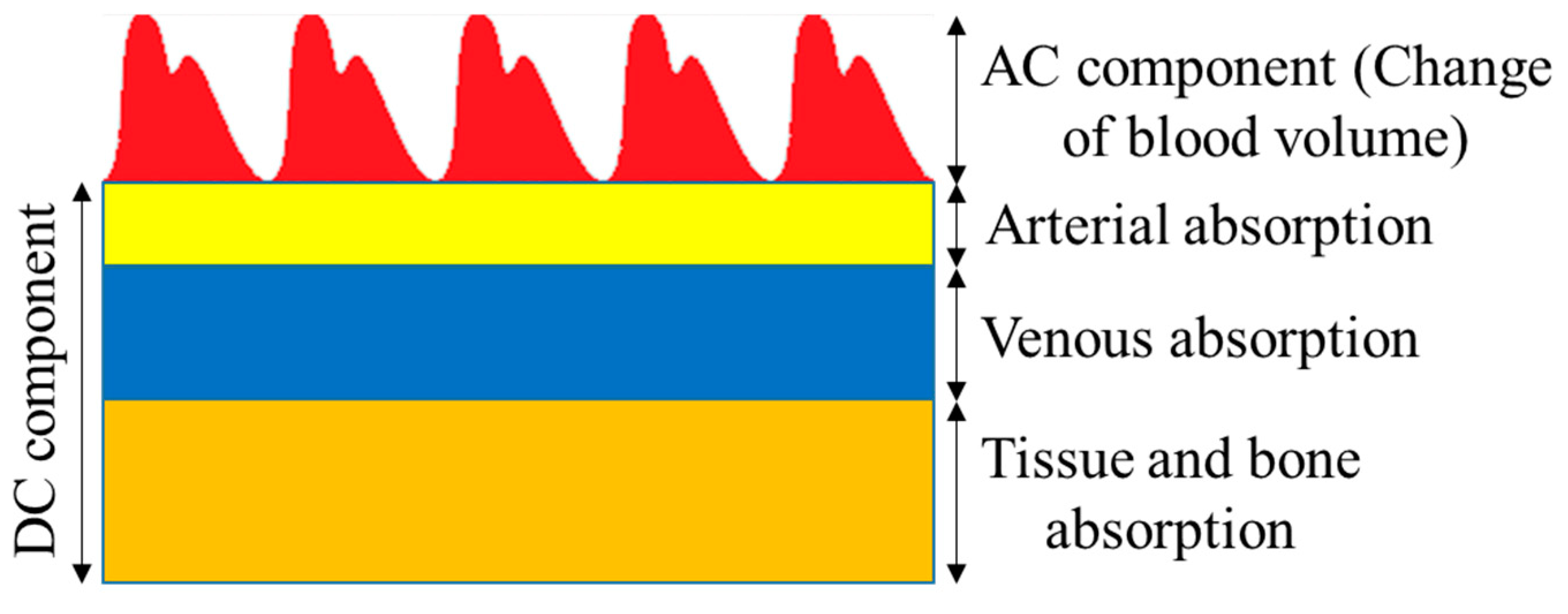
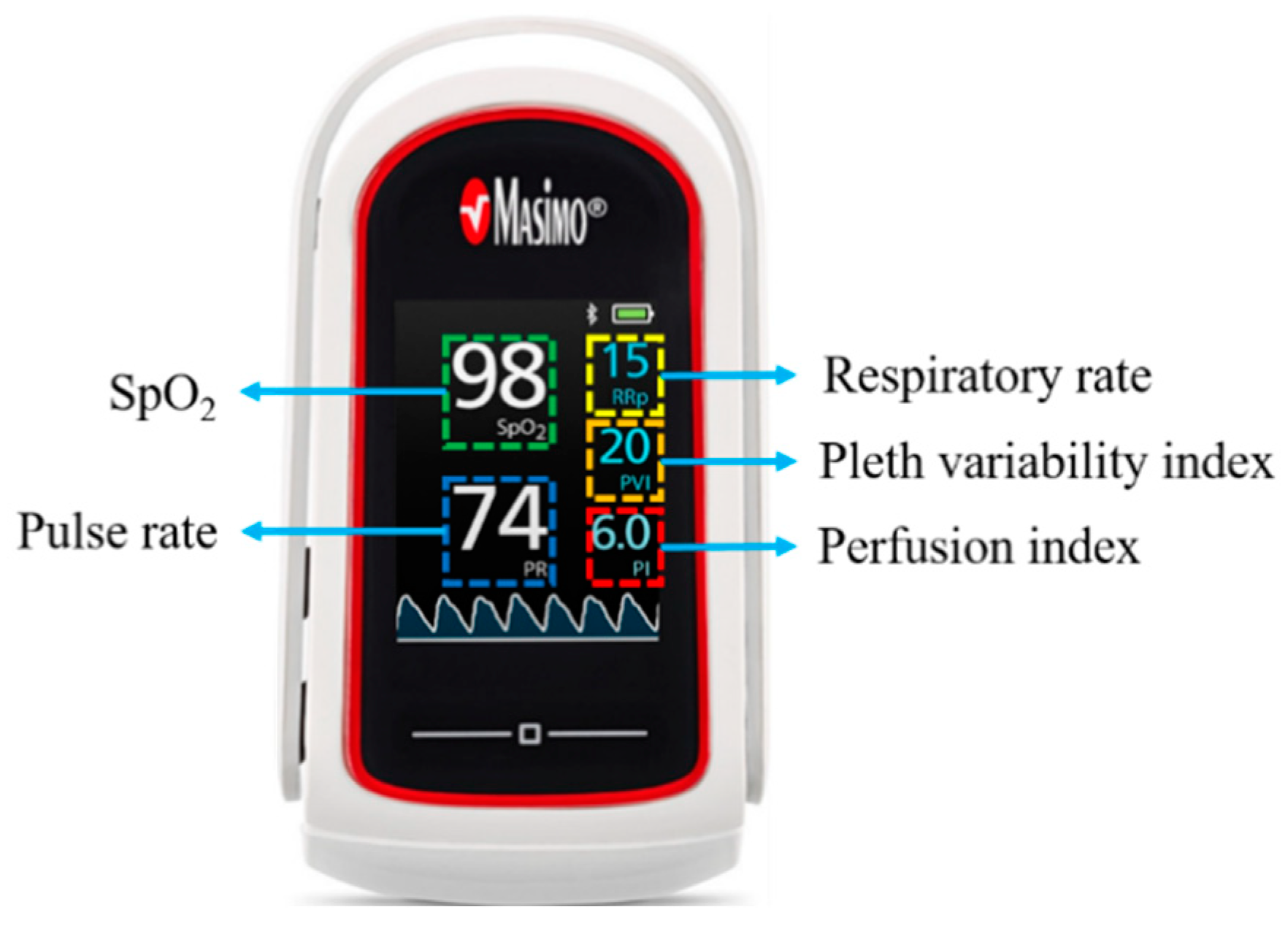
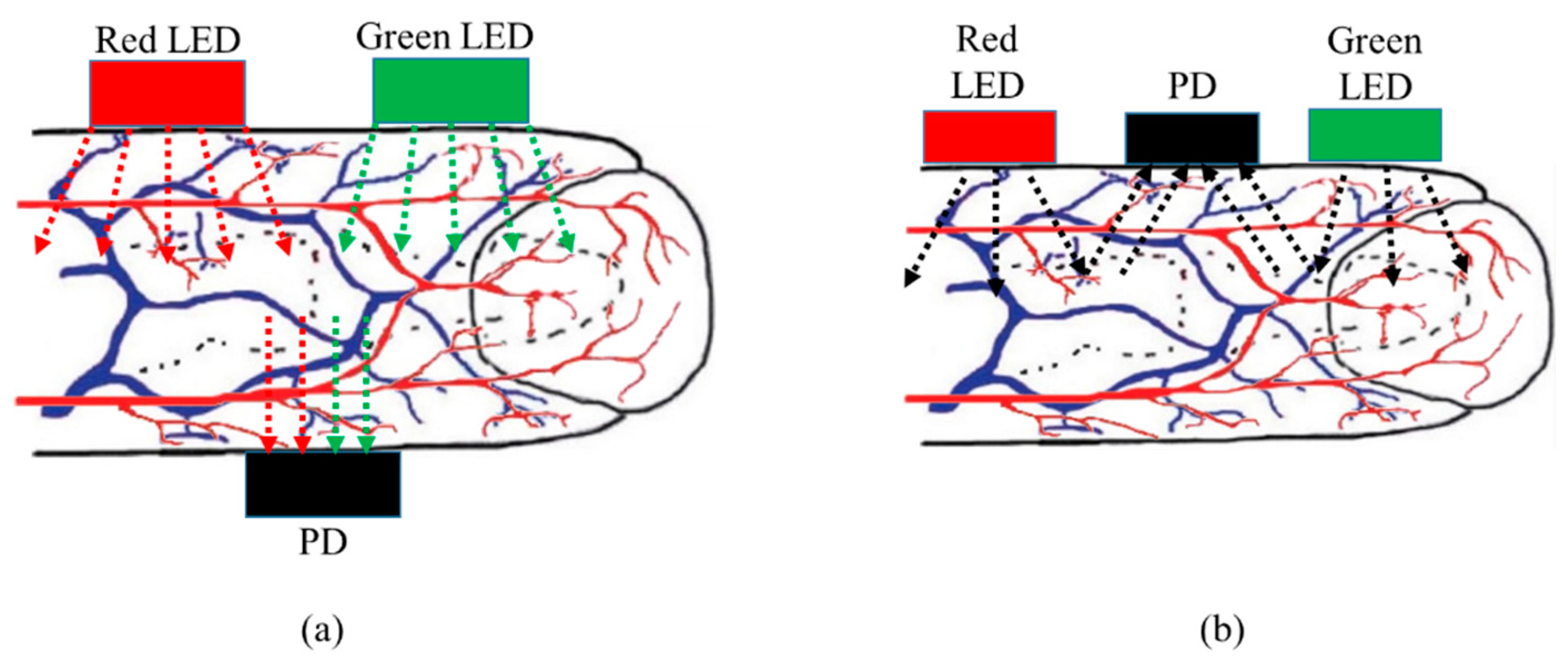

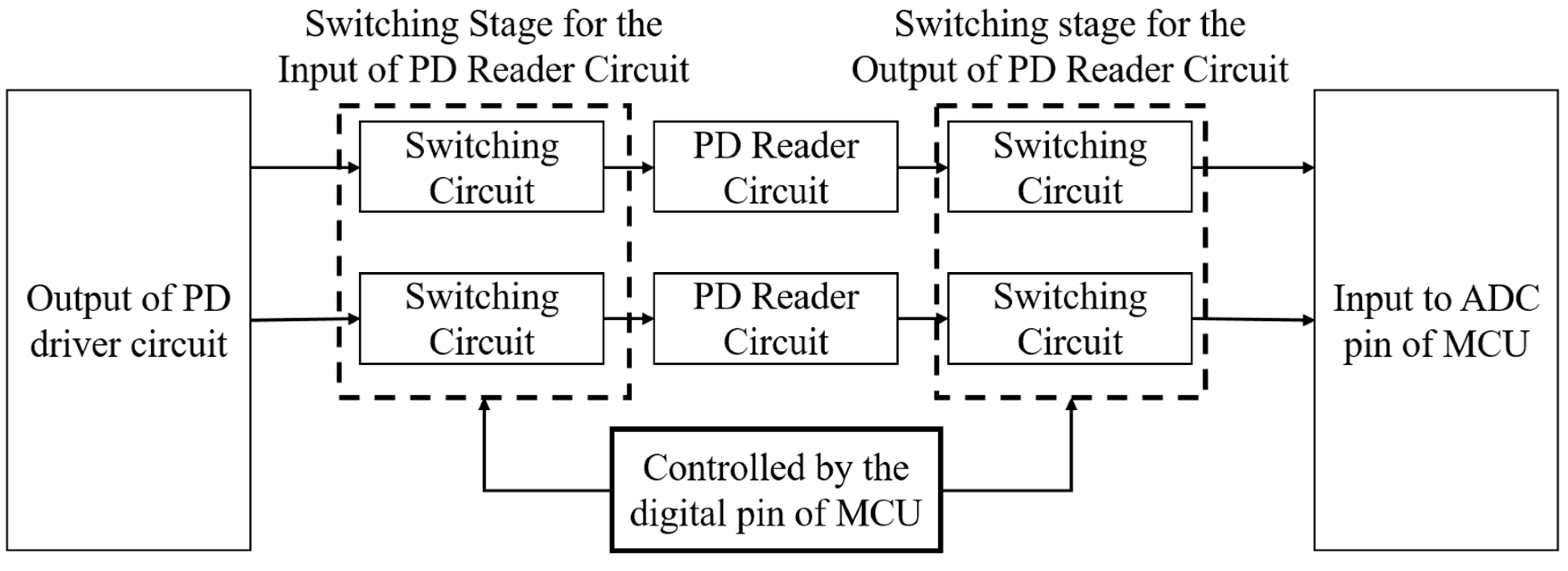



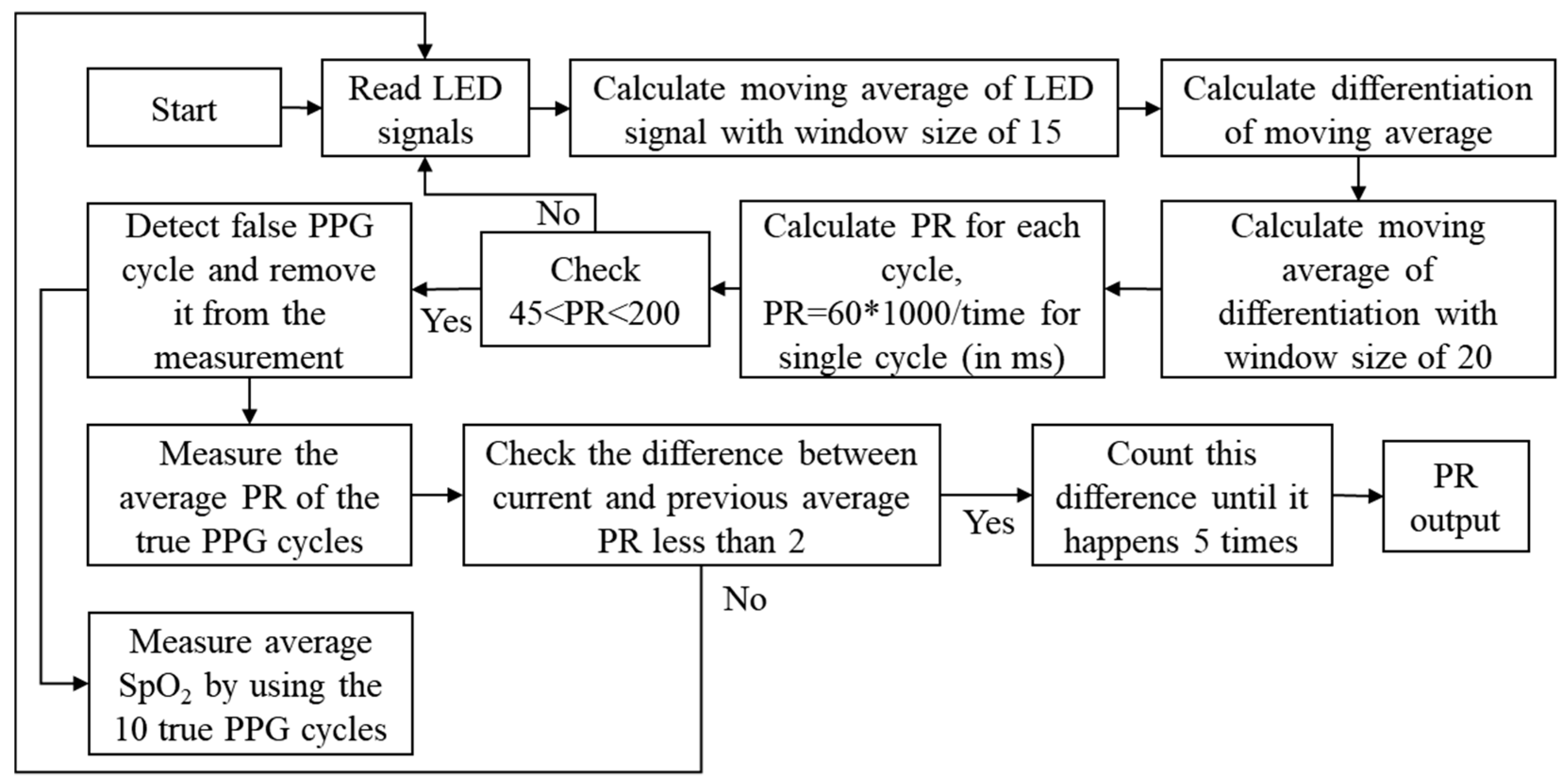
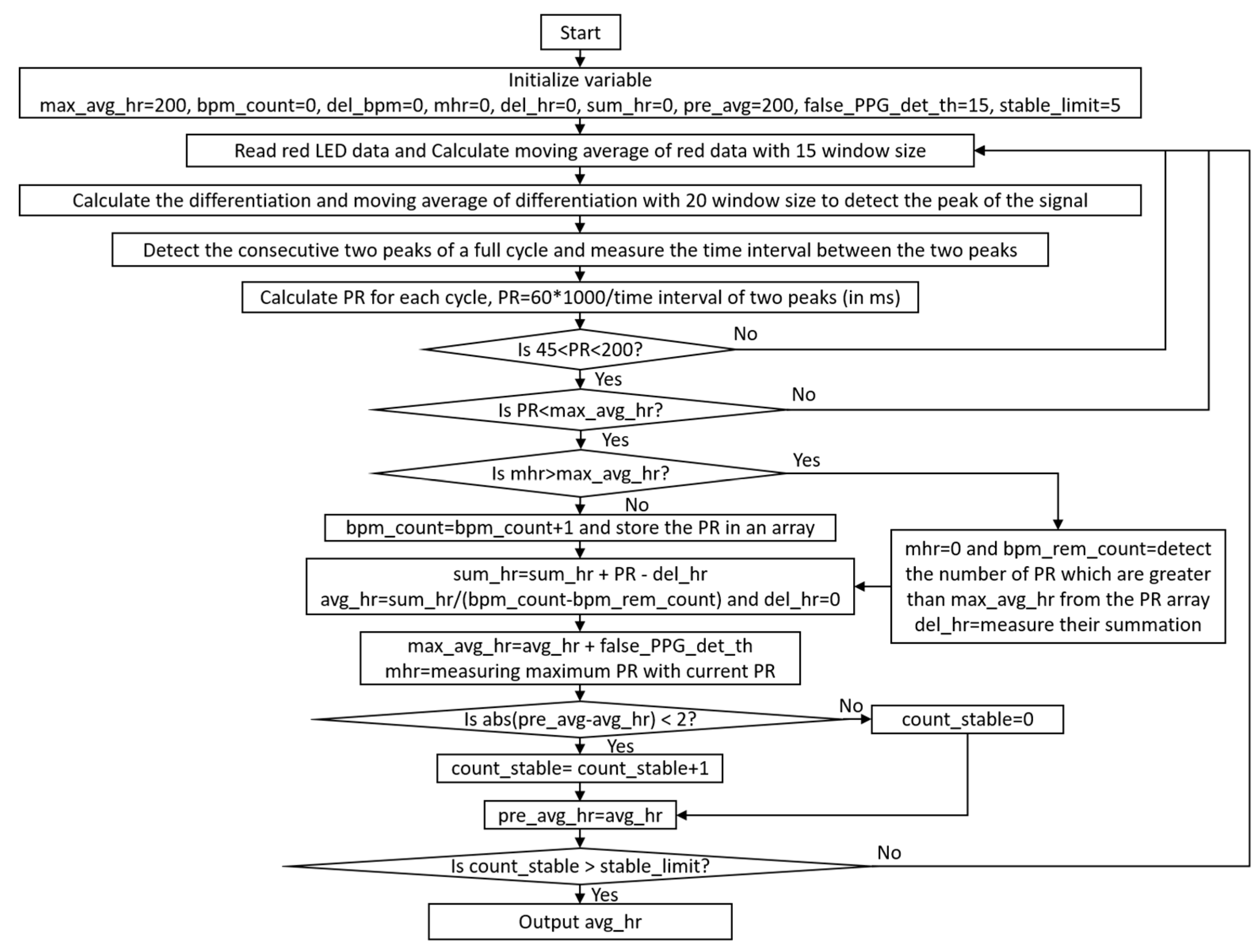
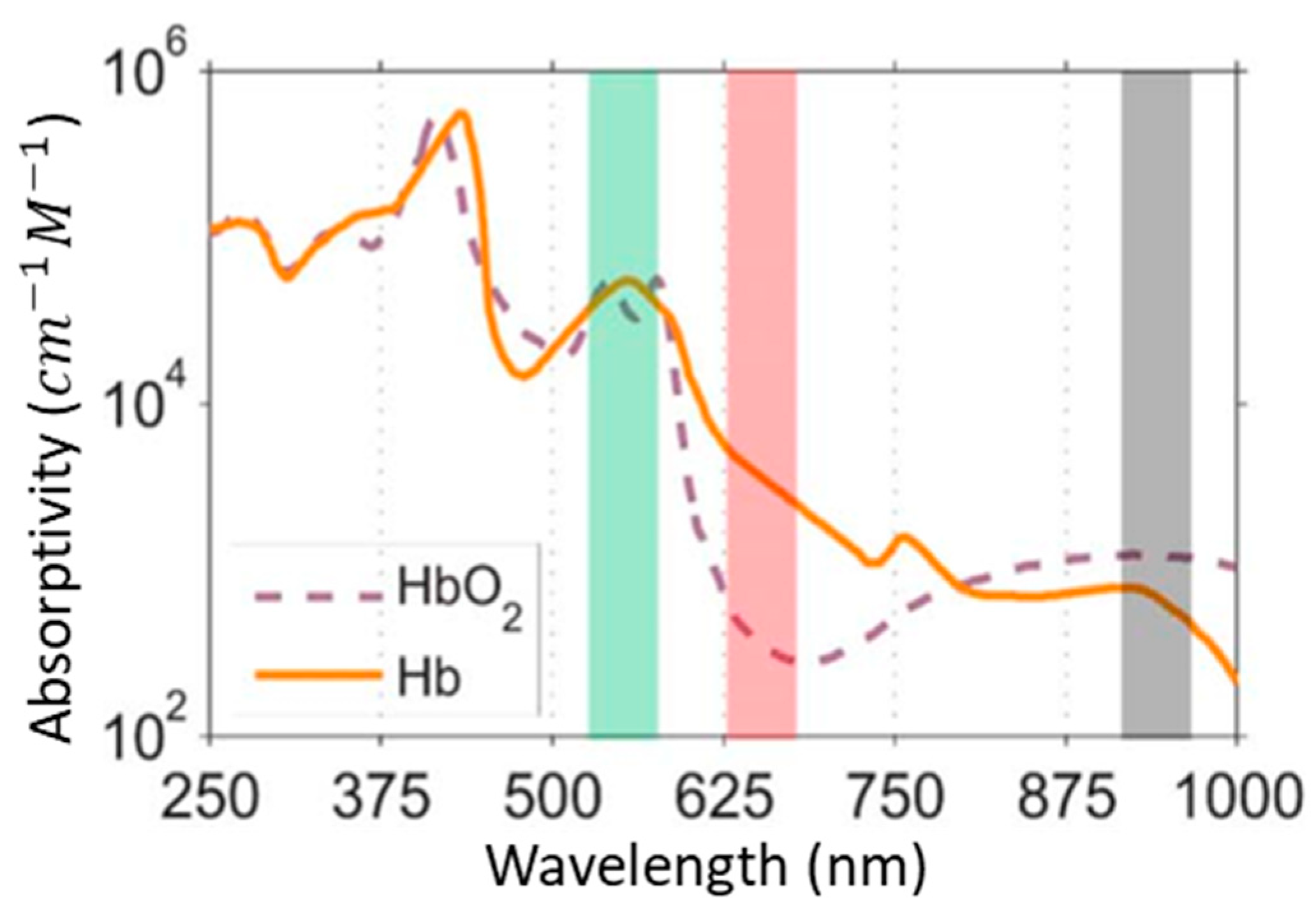

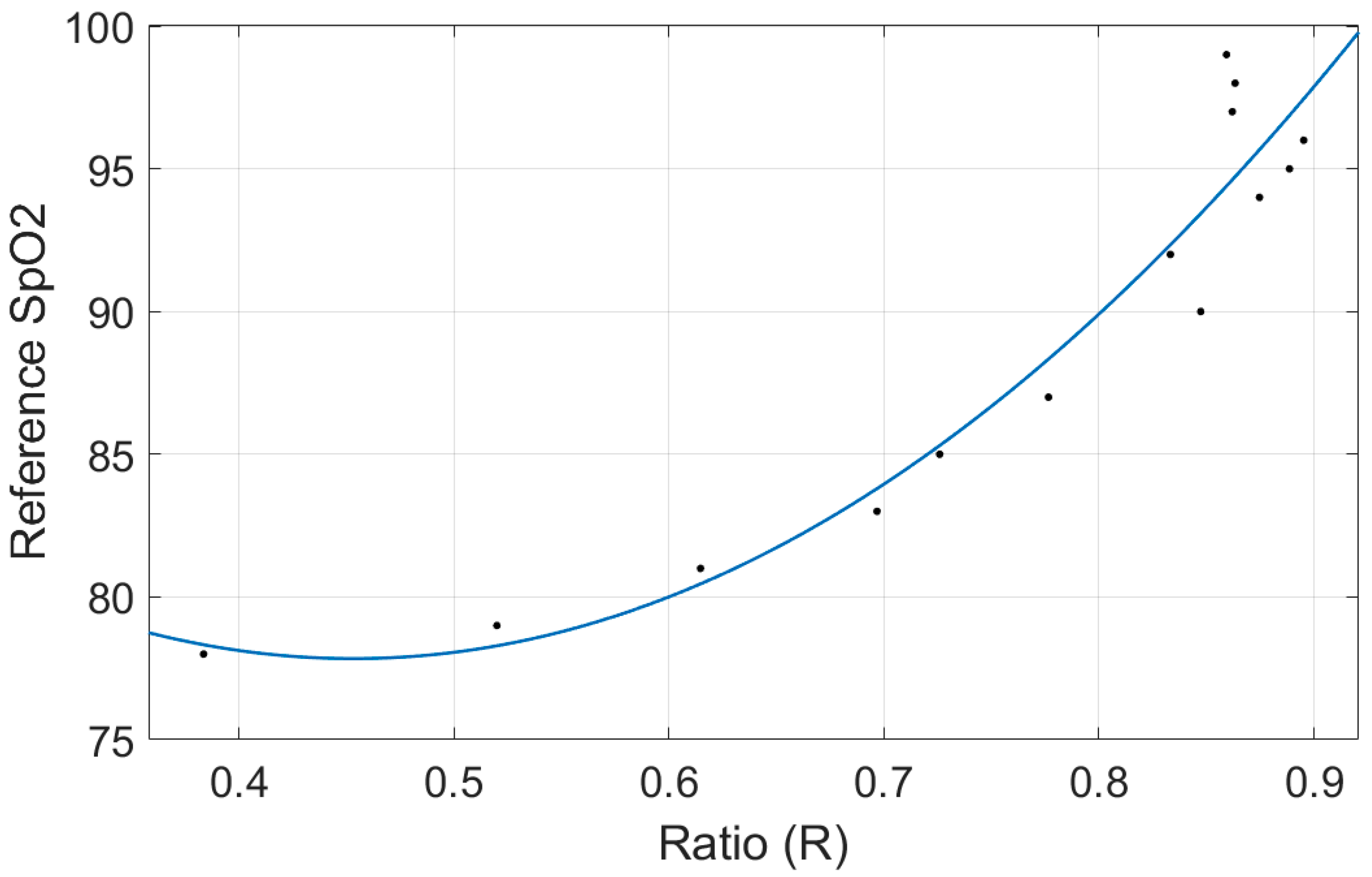
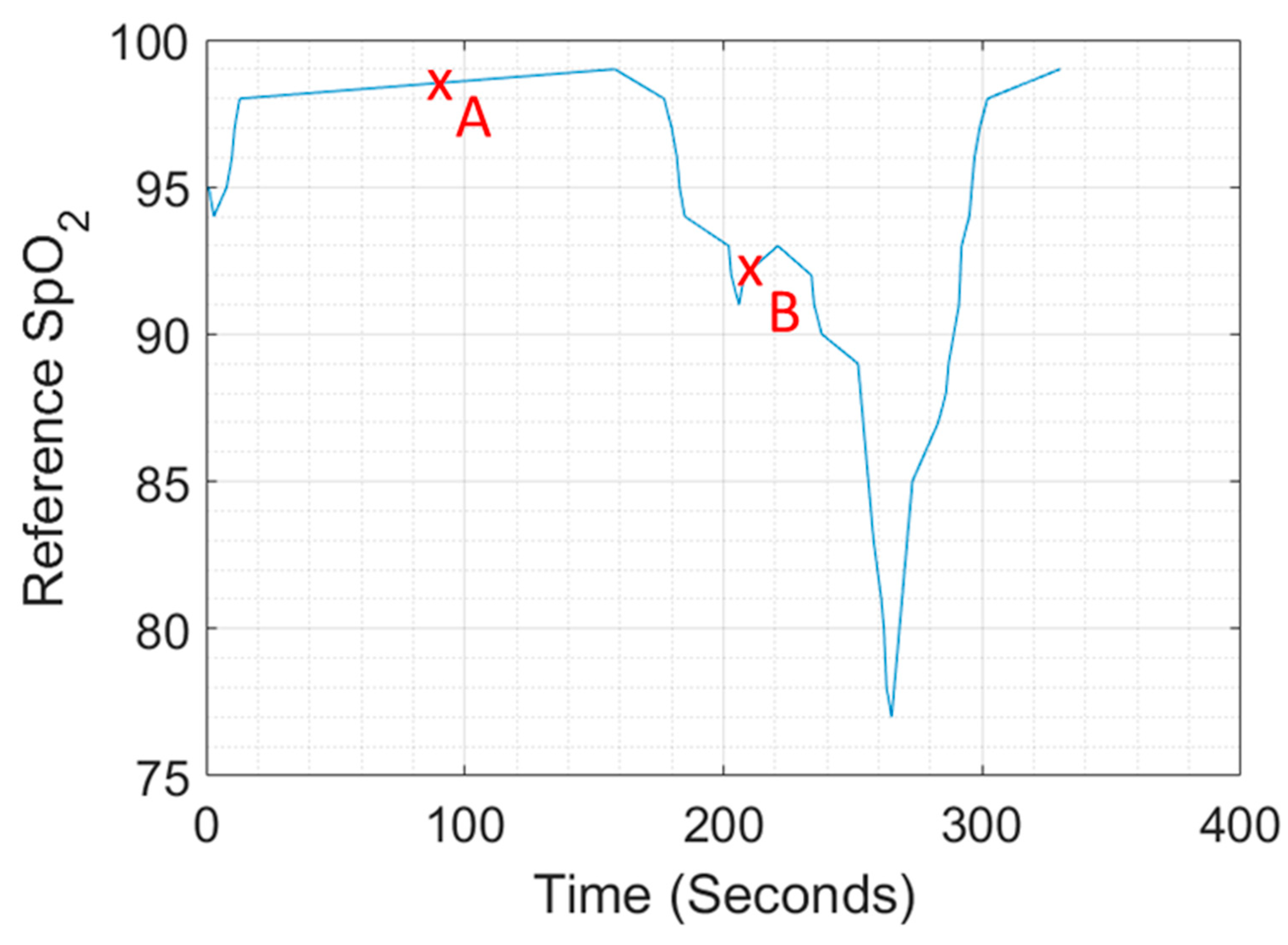

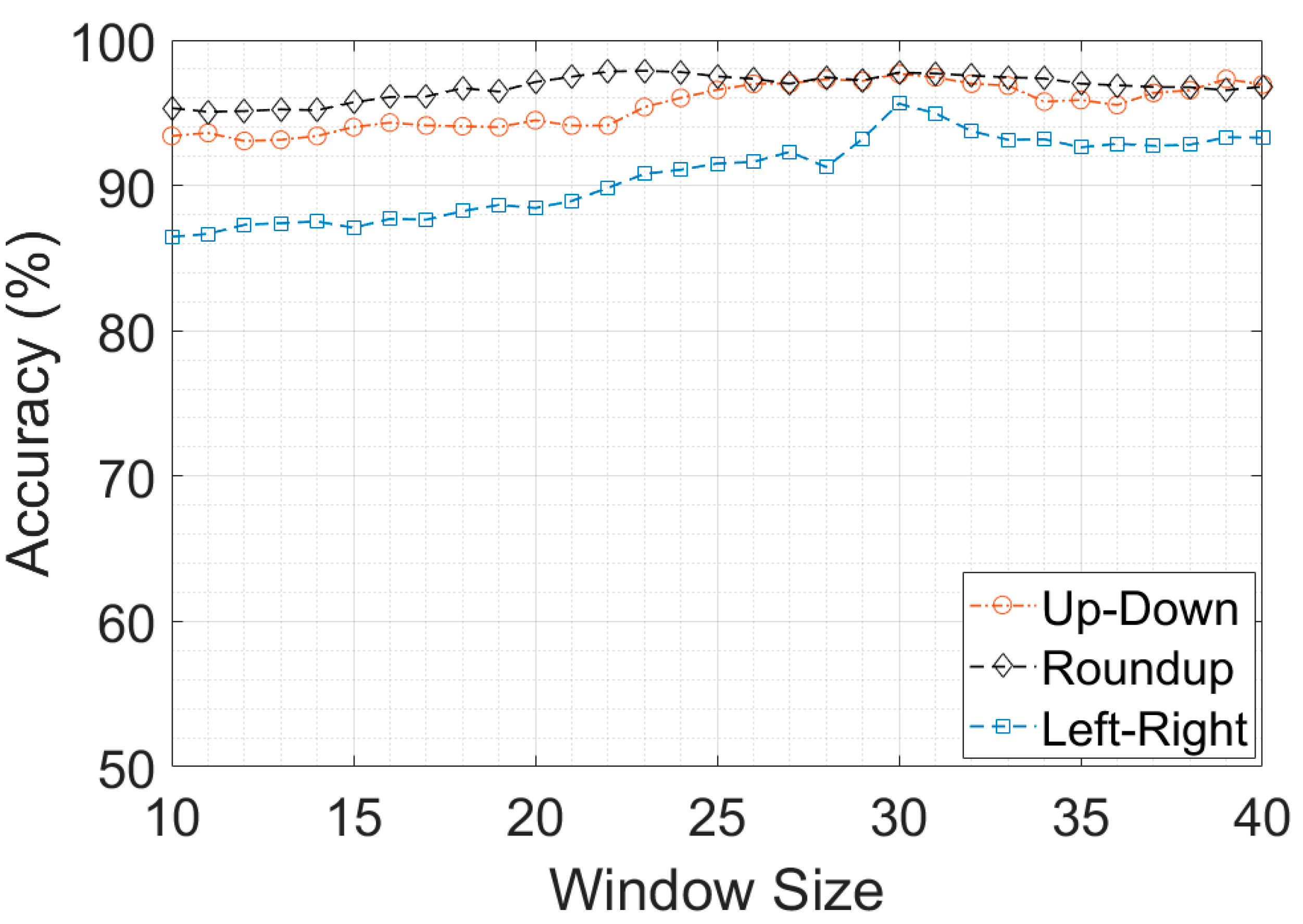
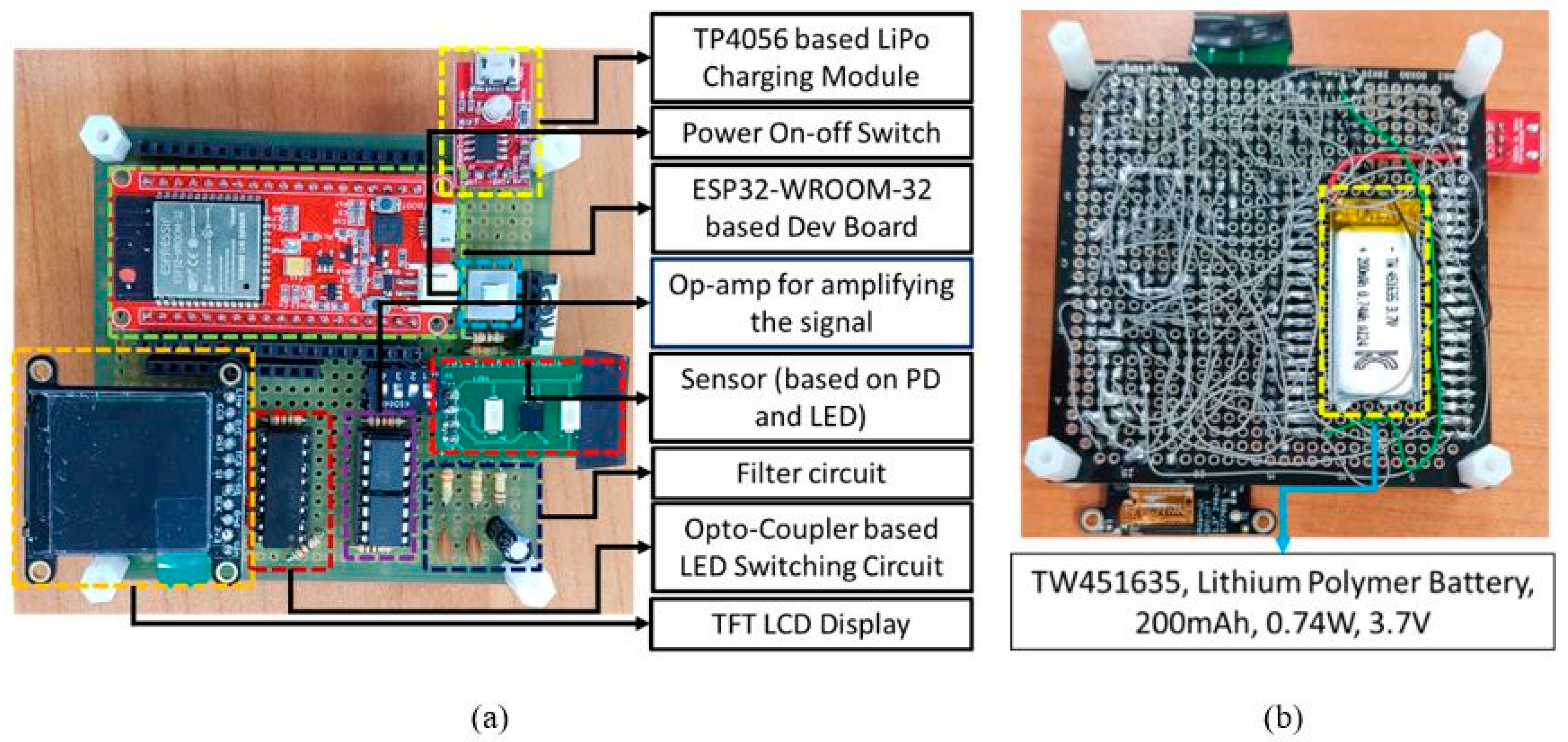
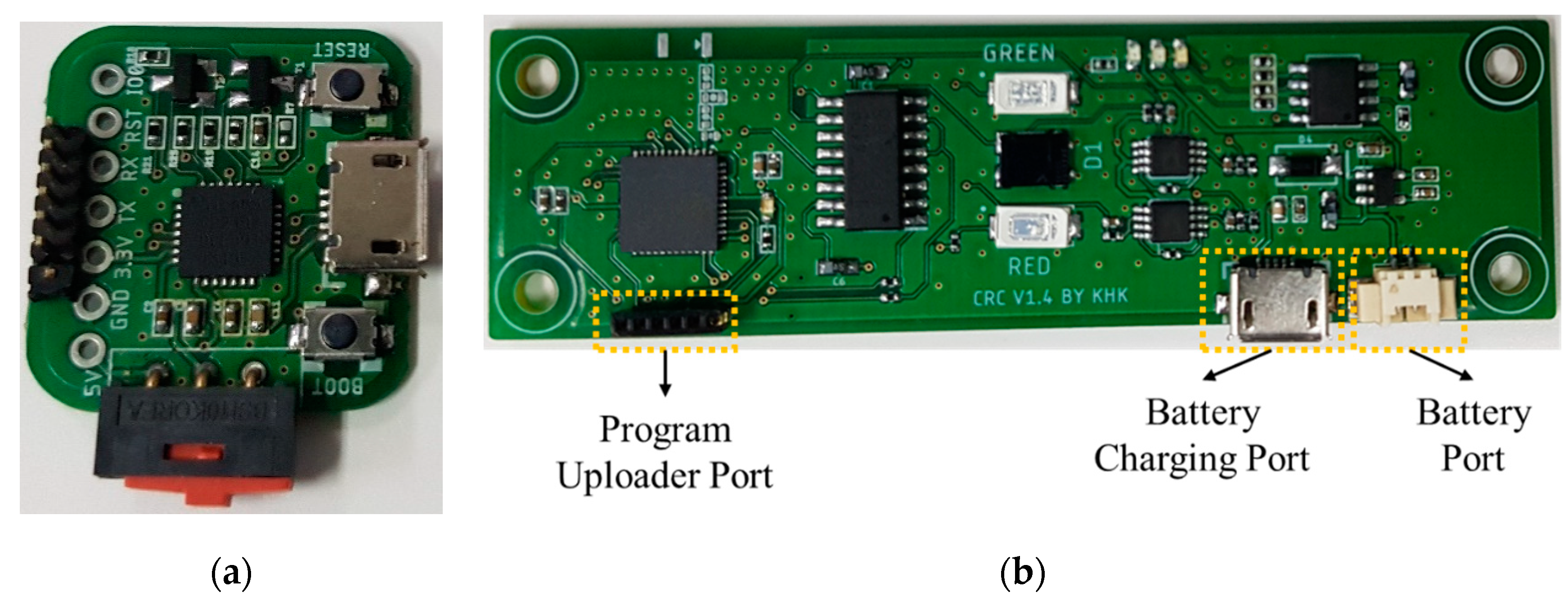
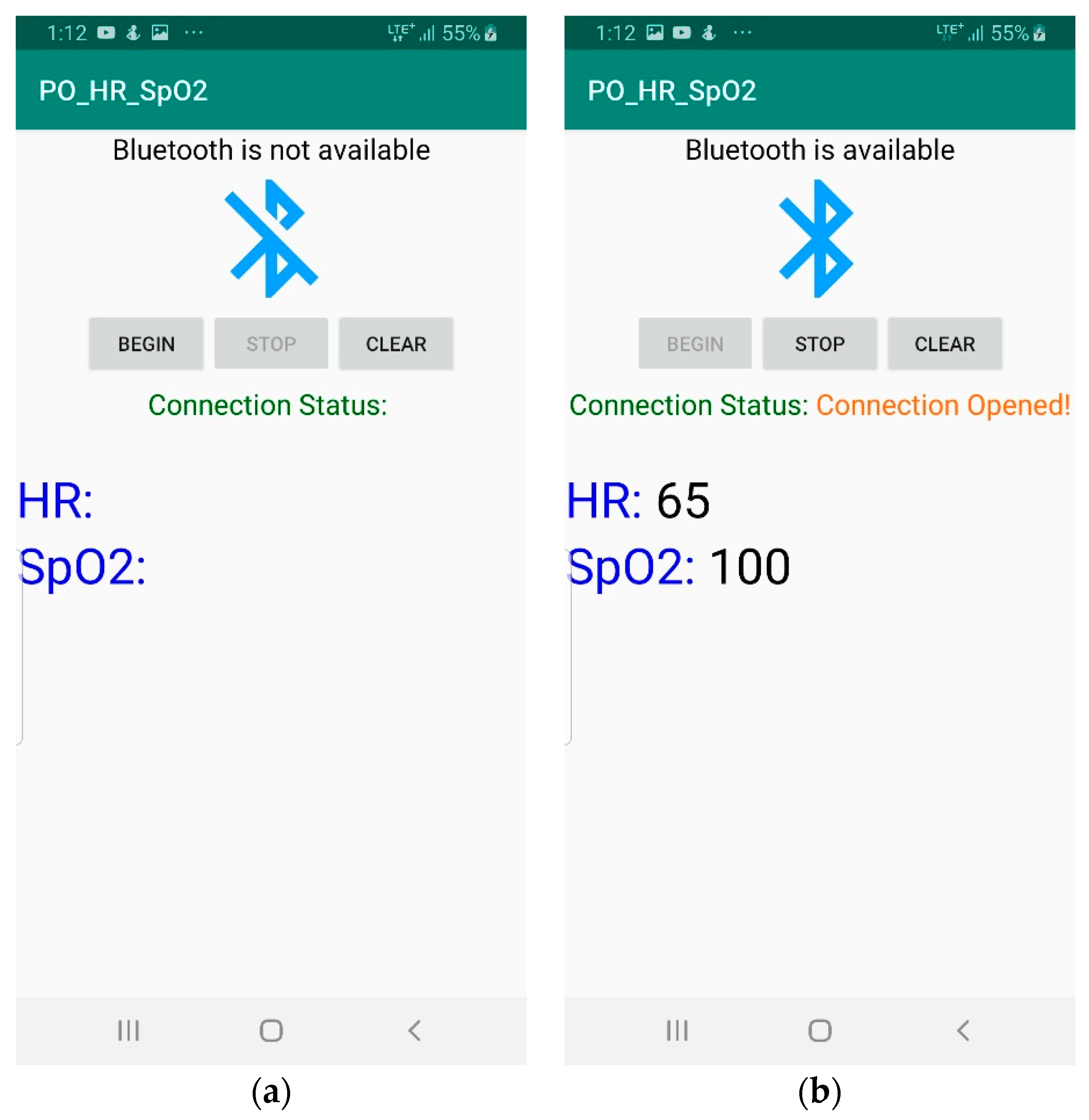
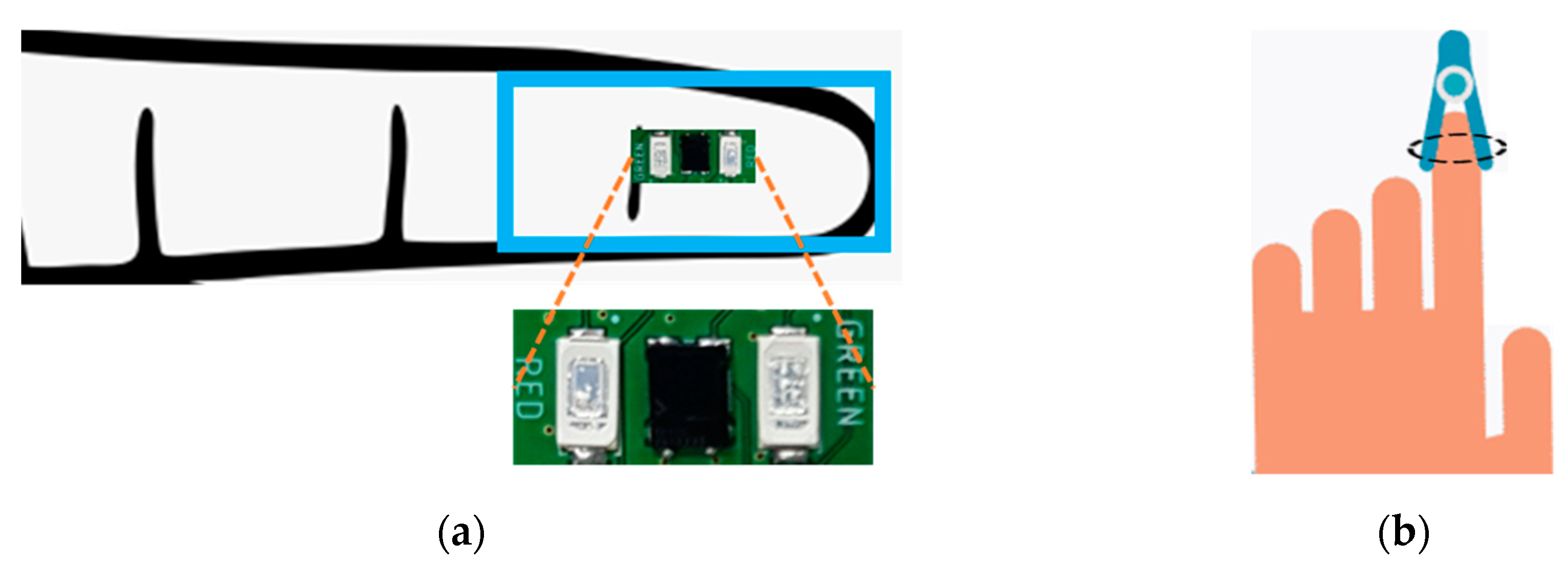


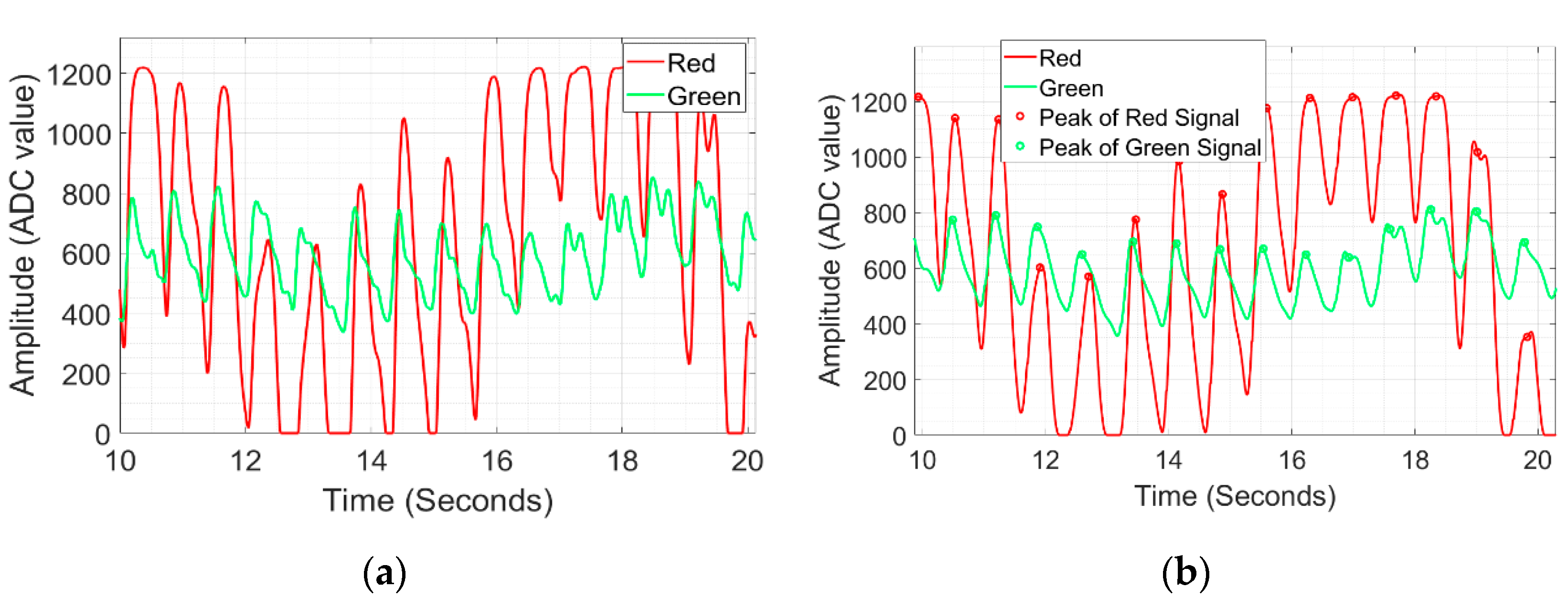



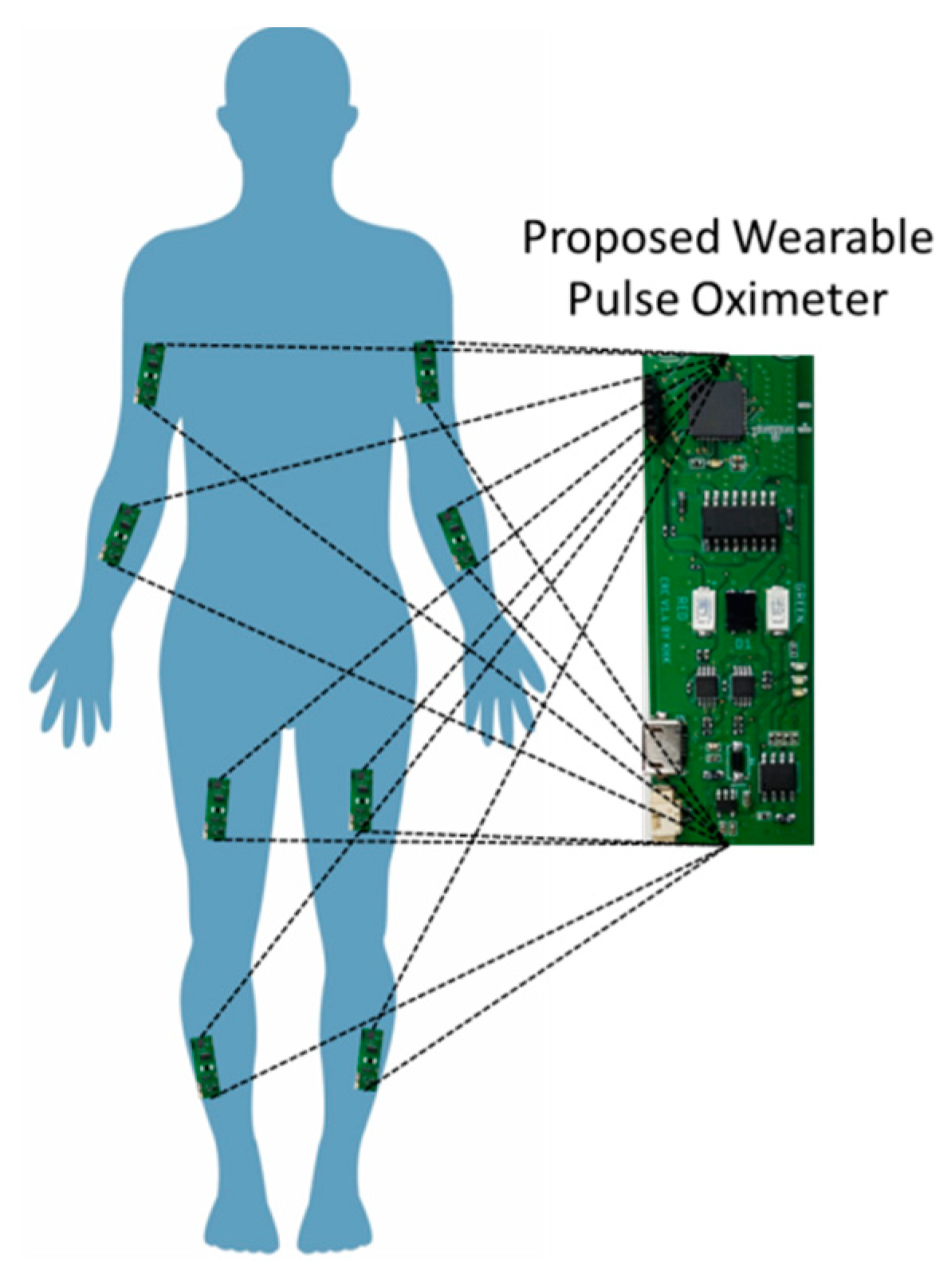

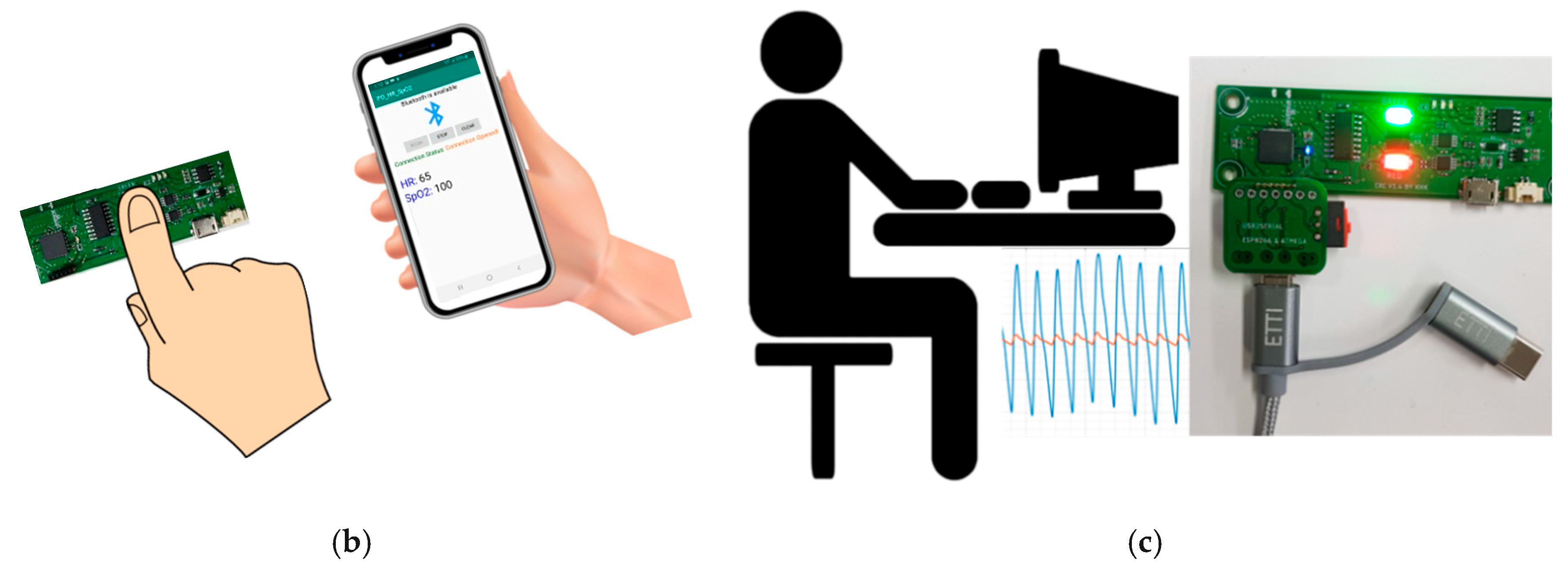
| Serial No. | Component Name | Characteristics | Manufacturer |
|---|---|---|---|
| 01 | Red LED, 5730 SMD LED | Operating voltage: 1.9–2.1 V, wavelength: 620–625 nm, maximum power dissipation: 0.5 W, light intensity: 14–16 lumen. | Cam Farm |
| 02 | Green LED, 5730 SMD LED | Operating voltage: 3.1–3.2 V, wavelength: 520–525 nm, maximum power dissipation: 0.5 W, light intensity: 20–25 lumen. | Cam Farm |
| 03 | PD, VEMD5510 C | Operating maximum reverse voltage: 20 V, dark current: 0.2–10 nA, maximum power dissipation: 215 mW, peak sensitivity: 550 nm, spectral bandwidth: 440–700 nm. | Vishay Semiconductor Opto Division |
| 04 | Op-amp, AD623 AN | Operating voltage: 2.7–12 V, power dissipation: 650 mW, slew rate: 0.3 V/µs, gain: 1–1000. | Analog Devices Inc. |
| 05 | Optocoupler, ILQ1, quad channel | Maximum forward current: 60 mA, LED forward voltage: 1.25–1.65 V, collector-emitter saturation voltage: 0.25–0.4 V, current transfer ratio: 20–300%, power dissipation: 250 mW, propagation delay high to low: 0.7 µs, propagation delay low to high: 1.4 µs. | Vishay Semiconductor Opto Division |
| 06 | Battery charging IC, TP4056 | Operating voltage: 4–8 V, regulated output voltage: 4.137–4.263 V, charging current up to 1000 mA, charge threshold 2.9 V. | NanJing Top Power ASIC Corp. |
| 07 | MCU, ESP-WROOM-32 | Two CPU cores, CPU clock frequency: 80–240 MHz, operating voltage: 2.7–3.6 V, operating average current: 80 mA, Bluetooth protocols: v4.2, and Wi-Fi protocols: 802.11 n up to 150 Mbps. | Espressif Systems |
| 08 | Resistors | 55 Ω, 82 Ω, 1 KΩ, 100 KΩ, 330 KΩ. | Cheil Electronics |
| 09 | Capacitors | 3.3 µF (electrolytic), 0.1 µF (ceramic). | SAMWON |
| 10 | Lithium Polymer Battery, TW451635 | Voltage supply: 3.7 V, capacity: 200 mAh, power rating: 0.74 W. | The Han Co., Ltd. |
| 11 | Adafruit 1.3 inch TFT display, ST7789, 240 × 240 | Operating voltage: 3.3–5 V, 16-bit full-color pixels, pixel density: 260 ppi. | ADAFRUIT |
| Subject | MAPE (%) | MAE (bpm) | RCF | SpO2 (%) (Our) | SpO2 (%) (Reference) |
|---|---|---|---|---|---|
| 1 | 5.60 | 3.94 | 0.96 | 97.33 | 99 |
| 2 | 4.14 | 3.61 | 0.96 | 99.25 | 98 |
| 3 | 4.16 | 3.12 | 0.97 | 97.63 | 97 |
| 4 | 2.80 | 2.13 | 0.97 | 95.27 | 96 |
| 5 | 3.87 | 3.06 | 0.96 | 96.00 | 96 |
| 6 | 3.15 | 2.18 | 0.97 | 96.59 | 95 |
| 7 | 0.27 | 0.22 | 0.99 | 95.97 | 97 |
| 8 | 2.44 | 1.93 | 0.98 | 98.13 | 97 |
| 9 | 1.70 | 1.36 | 0.98 | 98.24 | 96 |
| 10 | 1.75 | 1.14 | 0.98 | 99.00 | 99 |
| 11 | 3.22 | 2.14 | 0.97 | 98.09 | 98 |
| 12 | 0.02 | 0.01 | 0.99 | 99.03 | 97 |
| 13 | 3.57 | 2.77 | 0.97 | 94.87 | 95 |
| 14 | 2.18 | 1.19 | 0.98 | 96.11 | 94 |
| 15 | 3.37 | 2.48 | 0.97 | 97.34 | 97 |
| Subject | MAPE (%) | MAE (bpm) | RCF | SpO2 (%) (Our) | SpO2 (%) (Reference) |
|---|---|---|---|---|---|
| 1 | 7.89 | 6.46 | 0.95 | 92.12 | 98 |
| 2 | 8.85 | 7.82 | 0.92 | 91.55 | 97 |
| 3 | 6.78 | 5.59 | 0.94 | 94.18 | 99 |
| 4 | 4.13 | 3.22 | 0.96 | 98.57 | 96 |
| 5 | 1.23 | 0.96 | 0.99 | 95.89 | 96 |
| 6 | 7.43 | 6.16 | 0.93 | 92.44 | 96 |
| 7 | 3.36 | 2.65 | 0.97 | 97.54 | 99 |
| 8 | 1.82 | 1.67 | 0.98 | 98.88 | 98 |
| 9 | 7.64 | 6.80 | 0.93 | 93.12 | 98 |
| 10 | 5.85 | 3.69 | 0.96 | 96.19 | 99 |
| 11 | 2.96 | 2.18 | 0.97 | 96.45 | 98 |
| 12 | 0.56 | 0.40 | 0.99 | 94.96 | 97 |
| 13 | 7.13 | 8.94 | 0.94 | 92.59 | 97 |
| 14 | 3.31 | 1.88 | 0.98 | 95.45 | 97 |
| 15 | 5.39 | 4.07 | 0.96 | 94.55 | 97 |
| Subject | MAPE (%) | MAE (bpm) | RCF | SpO2 (%) (Our) | SpO2 (%) (Reference) |
|---|---|---|---|---|---|
| 1 | 7.89 | 6.46 | 0.95 | 92.12 | 98 |
| 2 | 8.85 | 7.82 | 0.92 | 91.55 | 97 |
| 3 | 6.78 | 5.59 | 0.94 | 94.18 | 99 |
| 4 | 4.13 | 3.22 | 0.96 | 98.57 | 96 |
| 5 | 1.23 | 0.96 | 0.99 | 95.89 | 96 |
| 6 | 7.43 | 6.16 | 0.93 | 92.44 | 96 |
| 7 | 3.36 | 2.65 | 0.97 | 97.54 | 99 |
| 8 | 1.82 | 1.67 | 0.98 | 98.88 | 98 |
| 9 | 7.64 | 6.80 | 0.93 | 93.12 | 98 |
| 10 | 5.85 | 3.69 | 0.96 | 96.19 | 99 |
| 11 | 2.96 | 2.18 | 0.97 | 96.45 | 98 |
| 12 | 0.56 | 0.40 | 0.99 | 94.96 | 97 |
| 13 | 7.13 | 8.94 | 0.94 | 92.59 | 97 |
| 14 | 3.31 | 1.88 | 0.98 | 95.45 | 97 |
| 15 | 5.39 | 4.07 | 0.96 | 94.55 | 97 |
| Subject | MAPE (%) | MAE (bpm) | RCF | SpO2 (%) (Our) | SpO2 (%) (Reference) |
|---|---|---|---|---|---|
| 1 | 7.13 | 6.22 | 0.92 | 90.06 | 97 |
| 2 | 5.61 | 5.45 | 0.93 | 92.79 | 96 |
| 3 | 5.91 | 4.42 | 0.96 | 95.63 | 99 |
| 4 | 0.10 | 0.07 | 0.99 | 95.39 | 95 |
| 5 | 0.49 | 0.36 | 0.99 | 96.11 | 96 |
| 6 | 2.16 | 1.53 | 0.98 | 94.85 | 96 |
| 7 | 6.41 | 5.19 | 0.99 | 90.31 | 96 |
| 8 | 7.67 | 7.16 | 0.96 | 89.72 | 97 |
| 9 | 8.47 | 6.85 | 0.96 | 88.89 | 97 |
| 10 | 1.93 | 1.31 | 0.98 | 98.93 | 99 |
| 11 | 4.24 | 3.10 | 0.96 | 96.50 | 98 |
| 12 | 1.53 | 1.12 | 0.98 | 98.84 | 98 |
| 13 | 5.86 | 4.56 | 0.95 | 92.41 | 96 |
| 14 | 2.99 | 1.78 | 0.98 | 96.41 | 98 |
| 15 | 6.51 | 5.53 | 0.97 | 90.26 | 97 |
| Condition | Subject | MAPE (%) | MAE (bpm) | RCF | SpO2 Accuracy (%) | ||||
|---|---|---|---|---|---|---|---|---|---|
| Our | FPO | Our | FPO | Our | FPO | Our | FPO | ||
| Without motion | 1 | 3.60 | 3.45 | 2.73 | 2.39 | 0.97 | 0.98 | 99.51 | 99.89 |
| 2 | 6.28 | 5.77 | 4.96 | 4.33 | 0.95 | 0.97 | 99.60 | 99.12 | |
| 3 | 3.26 | 3.44 | 2.25 | 2.39 | 0.97 | 0.96 | 98.73 | 98.86 | |
| 4 | 0.39 | 1.27 | 0.31 | 1.35 | 0.99 | 0.98 | 96.90 | 95.73 | |
| 5 | 2.44 | 3.13 | 1.92 | 2.66 | 0.98 | 0.97 | 96.90 | 96.22 | |
| 6 | 2.20 | 1.77 | 1.76 | 1.34 | 0.98 | 0.99 | 95.83 | 97.41 | |
| Left–right finger motion | 1 | 9.63 | 9.22 | 5.31 | 4.9 | 0.92 | 0.94 | 95.55 | 96.39 |
| 2 | 3.27 | 8.36 | 2.55 | 8.11 | 0.97 | 0.93 | 96.44 | 91.32 | |
| 3 | 6.73 | 8.12 | 4.40 | 7.22 | 0.95 | 0.92 | 96.17 | 92.57 | |
| 4 | 4.12 | 9.67 | 3.25 | 9.13 | 0.96 | 0.91 | 98.98 | 94.73 | |
| 5 | 8.78 | 10.15 | 7.20 | 9.68 | 0.93 | 0.9 | 97.95 | 94.19 | |
| 6 | 7.28 | 11.37 | 5.60 | 10.55 | 0.94 | 0.87 | 98.04 | 93.89 | |
| Up-down finger motion | 1 | 4.88 | 5.62 | 3.56 | 4.78 | 0.96 | 0.94 | 95.83 | 91.73 |
| 2 | 1.95 | 2.32 | 1.41 | 1.98 | 0.98 | 0.96 | 96.77 | 90.56 | |
| 3 | 3.81 | 8.77 | 2.70 | 7.97 | 0.97 | 0.94 | 96.25 | 93.78 | |
| 4 | 7.59 | 10.11 | 5.52 | 8.91 | 0.94 | 0.89 | 97.95 | 91.33 | |
| 5 | 3.59 | 9.65 | 2.84 | 8.74 | 0.97 | 0.91 | 95.83 | 88.48 | |
| 6 | 8.94 | 13.55 | 7.69 | 11.29 | 0.92 | 0.84 | 98.37 | 89.77 | |
| Round-up finger motion | 1 | 0.33 | 5.48 | 0.25 | 4.67 | 0.99 | 0.93 | 94.73 | 87.71 |
| 2 | 9.61 | 13.12 | 7.21 | 12.42 | 0.92 | 0.88 | 96.90 | 93.05 | |
| 3 | 5.49 | 10.16 | 3.90 | 8.78 | 0.96 | 0.9 | 95.83 | 89.09 | |
| 4 | 8.81 | 11.58 | 7.09 | 10.37 | 0.92 | 0.88 | 97.57 | 91.88 | |
| 5 | 8.67 | 16.62 | 8.16 | 15.22 | 0.91 | 0.85 | 96.90 | 84.43 | |
| 6 | 7.98 | 19.11 | 6.70 | 18.61 | 0.94 | 0.81 | 95.75 | 85.67 | |
Publisher’s Note: MDPI stays neutral with regard to jurisdictional claims in published maps and institutional affiliations. |
© 2020 by the authors. Licensee MDPI, Basel, Switzerland. This article is an open access article distributed under the terms and conditions of the Creative Commons Attribution (CC BY) license (http://creativecommons.org/licenses/by/4.0/).
Share and Cite
Banik, P.P.; Hossain, S.; Kwon, T.-H.; Kim, H.; Kim, K.-D. Development of a Wearable Reflection-Type Pulse Oximeter System to Acquire Clean PPG Signals and Measure Pulse Rate and SpO2 with and without Finger Motion. Electronics 2020, 9, 1905. https://doi.org/10.3390/electronics9111905
Banik PP, Hossain S, Kwon T-H, Kim H, Kim K-D. Development of a Wearable Reflection-Type Pulse Oximeter System to Acquire Clean PPG Signals and Measure Pulse Rate and SpO2 with and without Finger Motion. Electronics. 2020; 9(11):1905. https://doi.org/10.3390/electronics9111905
Chicago/Turabian StyleBanik, Partha Pratim, Shifat Hossain, Tae-Ho Kwon, Hyoungkeun Kim, and Ki-Doo Kim. 2020. "Development of a Wearable Reflection-Type Pulse Oximeter System to Acquire Clean PPG Signals and Measure Pulse Rate and SpO2 with and without Finger Motion" Electronics 9, no. 11: 1905. https://doi.org/10.3390/electronics9111905
APA StyleBanik, P. P., Hossain, S., Kwon, T.-H., Kim, H., & Kim, K.-D. (2020). Development of a Wearable Reflection-Type Pulse Oximeter System to Acquire Clean PPG Signals and Measure Pulse Rate and SpO2 with and without Finger Motion. Electronics, 9(11), 1905. https://doi.org/10.3390/electronics9111905









